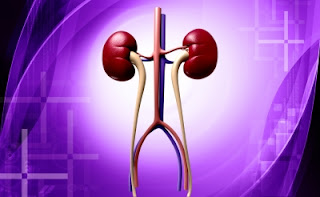Starting from the basics: The kidneys' structure and function
I want the first post to address the absolute basics about the kidneys. Looking at this from a patient's perspective, I am often surprised by how little some of my patients know about the kidneys. I guess the lay press has a done a pretty good job of educating everyone about the other "more glamorous" organs! Everyone realizes the important roles played by the heart, the brain....even the liver gets its fare share of the limelight with everyone realizing the connection between liver disease and alcohol intake. The questions that I get asked often range from, "what do the kidneys do", "what/where are they", "why should I be worried about kidney disease"?
"Image courtesy of [Dream Designs] / FreeDigitalPhotos.net"
So here goes:
The kidneys are two bean shaped organs in your flanks, just below the rib cage. They range in size from 8 to 14 centimeters (or 3-4 inches). They are the silent workhorses who work 24x7 to clean your blood of impurities and toxins that build up from the body's metabolism, produce hormones essential to make blood cells (erythropoietin) and making sure that your bones stay healthy (via vitamin D production), dump excess acid out from your system, control your blood pressure, etc. About 380 gallons (1440 liters) of blood flows through the kidneys every day! It is not surprising then that kidney disease is associated with wide ranging complications (which I will cover over the later posts).
The kidneys are two bean shaped organs in your flanks, just below the rib cage. They range in size from 8 to 14 centimeters (or 3-4 inches). They are the silent workhorses who work 24x7 to clean your blood of impurities and toxins that build up from the body's metabolism, produce hormones essential to make blood cells (erythropoietin) and making sure that your bones stay healthy (via vitamin D production), dump excess acid out from your system, control your blood pressure, etc. About 380 gallons (1440 liters) of blood flows through the kidneys every day! It is not surprising then that kidney disease is associated with wide ranging complications (which I will cover over the later posts).



I think you made a mistake, kidneys cannot filter 1440 liters a day that would be a GFR of 1 liter per minute.
ReplyDeleteDuly noted. I apologize. "Filter" is probably not the right word to use. The words I should have used is "the amount of blood flowing through the kidneys every minute". This is based on the kidneys getting 20% of the cardiac output of 5 liters a minute. Hence, 1 liter/minute = 1440 liters a day! By the way, I am a big fan of your blog, Precious Bodily Fluids, and have been reading it since I was a fellow. You are a prolific blogger and I am amazed how do you find the time to do so much! I loved the post where you shred Dr Spry's views on alcohol and kidney disease; which is why I wrote my current post. Thank you, also for mentioning my blog on your last post.
ReplyDelete